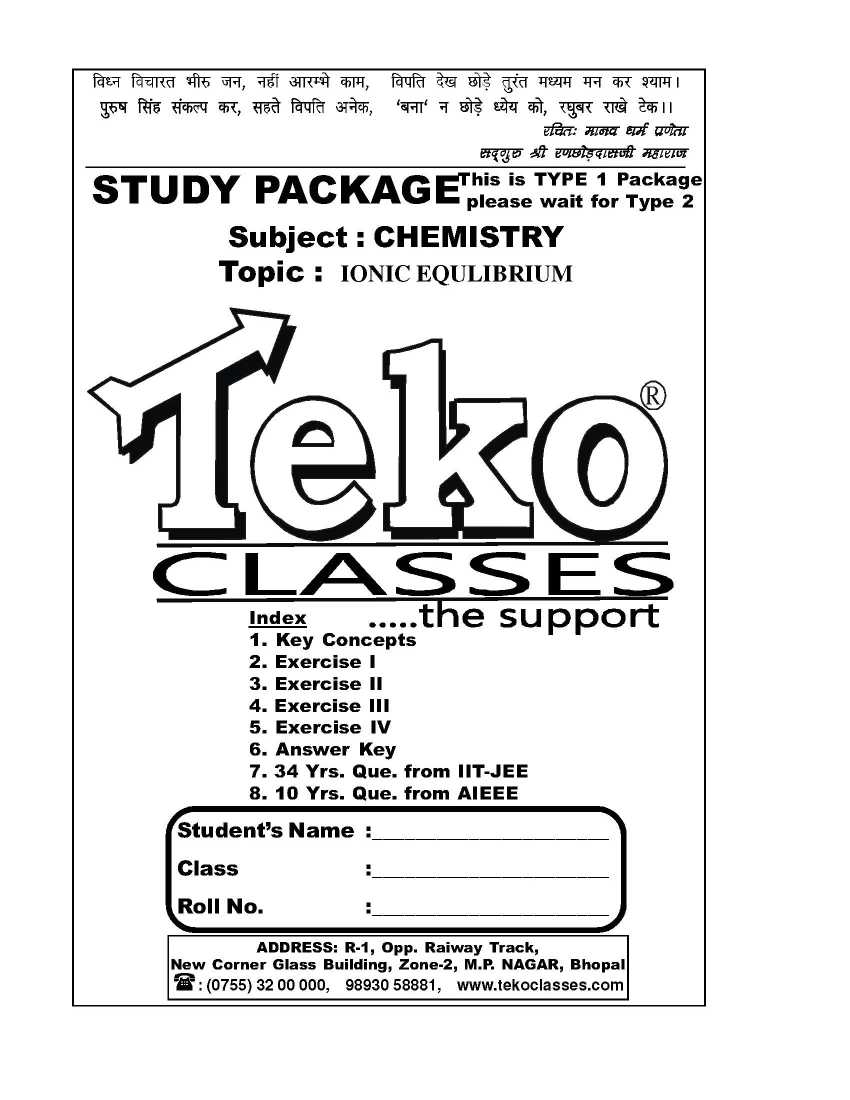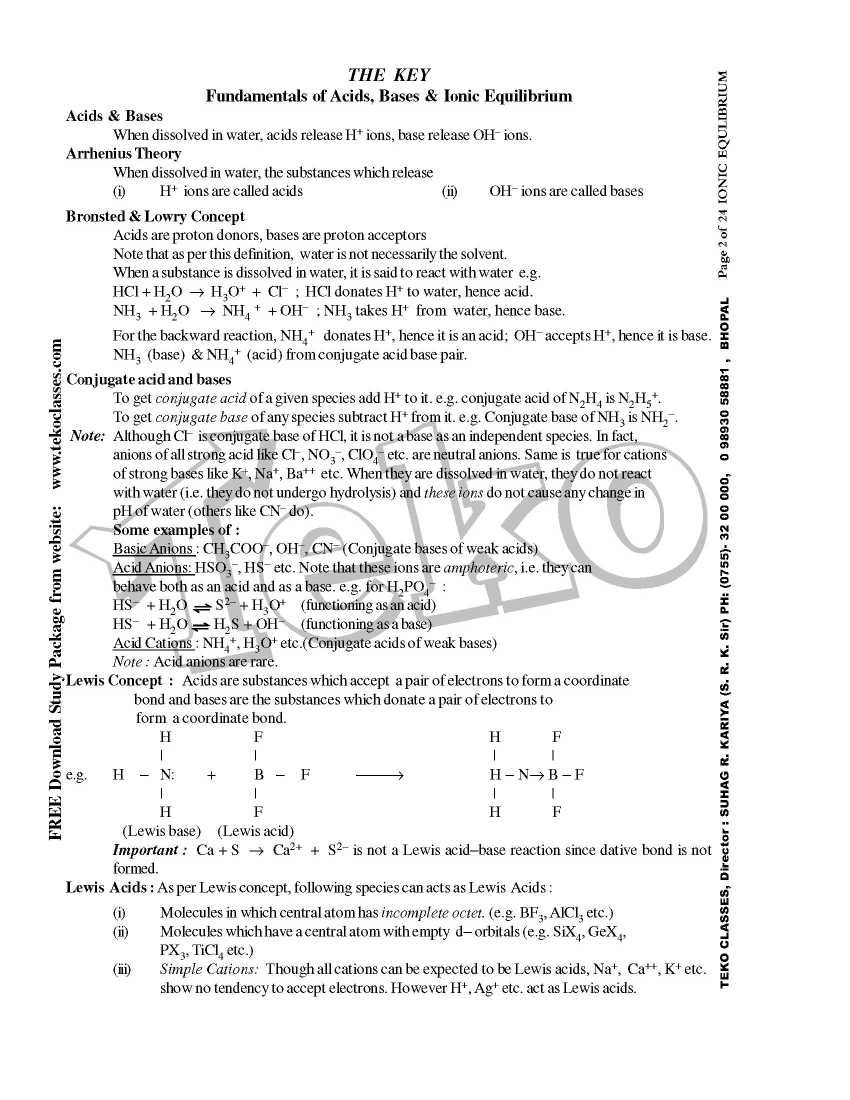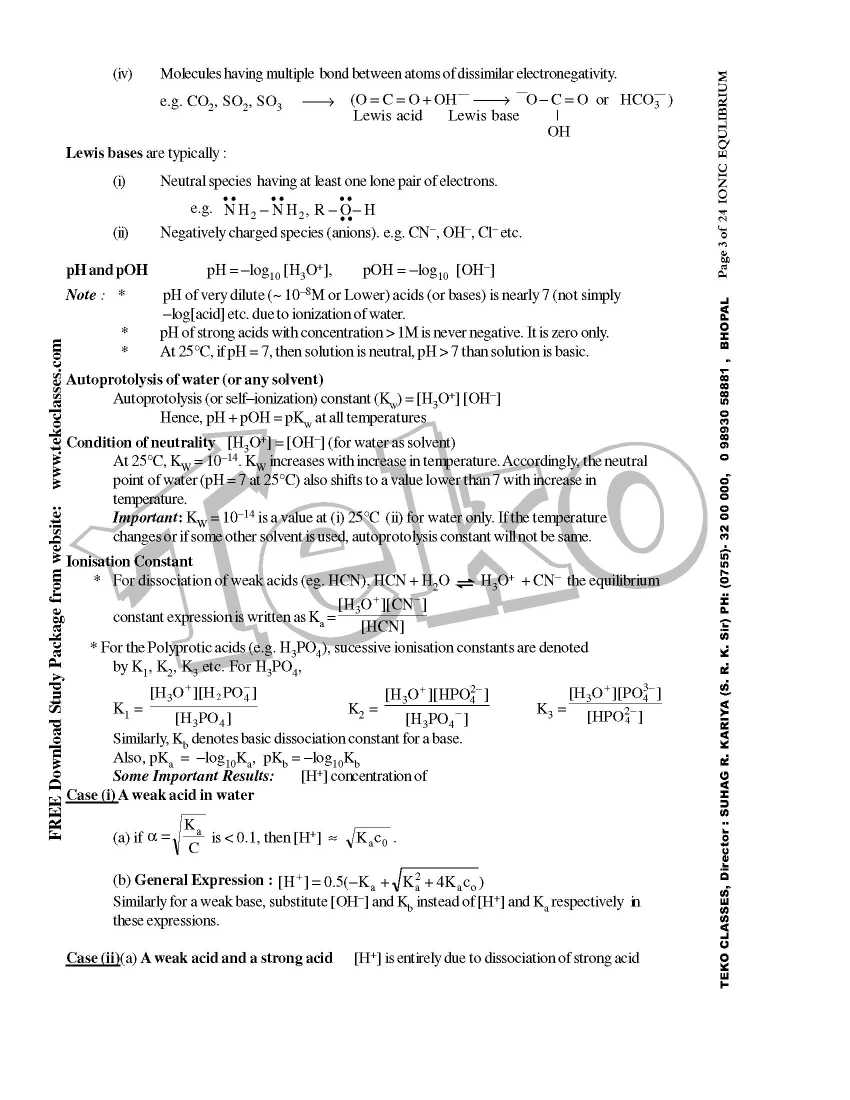|
#1
April 3rd, 2017, 03:11 PM
| |||
| |||
| Ionic Equilibrium IIT JEE Problems
I am doing preparation for IIT JEE Exam. Right now I am preparing for Chemistry Subject. I want sample questions based on Ionic Equilibrium topic. So tell me from where I can get sample questions on Ionic Equilibrium? Can you provide notes to clear all problems of this Topic of IIT JEE Exam? Here I am providing important notes based on Ionic Equilibrium Topic of IIT JEE Examination for your reference: IIT JEE Chemistry - Ionic Equilibrium Notes Acids & Bases When dissolved in water, acids release H + ions, base release OH – ions. Arrhenius Theory When dissolved in water, the substances which release (i) H + ions are called acids (ii) OH − ions are called bases Bronsted & Lowry Concept Acids are proton donors, bases are proton acceptors Note that as per this definition, water is not necessarily the solvent. When a substance is dissolved in water, it is said to react with water e.g. Lewis Acids : As per Lewis concept, following species can acts as Lewis Acids : (i) Molecules in which central atom has incomplete octet. (ii) Molecules which have a central atom with empty d− orbitals (iii) Simple Cations: Though all cations can be expected to be Lewis acids, HYDROLYSIS Indicators. Indicator is a substance which indicates the point of equivalence in a titration by undergoing a change in its colour. They are weak acids or weak bases. Theory of Indicators. The ionized and unionized forms of indicators have different colours. If 90 % or more of a particular form (ionised or unionised) is present, then its colour can be distinclty seen. In general, for an indicator which is weak acid, Table 1 : Indicators Indicators pH range Colour Acid Medium Basic Medium Methyl Orange 3.1-4.4 pink yellow Methyl red 4.2-6.3 red yellow Litmus 5.5-7.5 red blue Phenol red 6.8-8.4 yellow red Phenolphathlene 8.3-10 colourless pink Thymol blue 1.2-2.8 red yellow IIT JEE Chemistry - Ionic Equilibrium Notes     IIT JEE Chemistry - Ionic Equilibrium Sample Questions Question 1: Calculate the pH of the solution when 0.1 M CH3 COOH (50 ml) and 01. M NaOH (50 ml) are mixed, [Ka (CH3COOH)=10-5] Solution: CH3 COOH \rightleftharpoons CH3 COO_ + H+ …(I) NaOH → Na+ + OH- H+ + OH_ \rightleftharpoonsH2O …(II) (I) + (II) CH3COOH + OH- CH3COO- + H2O . (III) 0.05-X 0.05-x x Keq of eq. (III) = Ka/Kw conc. of H2O remain constant 109 = x/(0.05-x)2 because value of eq. Const.is very high here for x» 0.05 let 0.05-x=a 109=0.05/a2 a = 7.07\times10-6 pOH= 6-log 7.07 pOH= 6 – 0.85 pH= 14-6+0.85 = 8.85 __________________________________________________ ______________________________________ Question 2: Calculate the pH at the equivalence point of the titration between 0.1M CH3*COOH ( 25 ml) with 0.05 M NaOH. Ka (CH3COOH) = 1.8 \times 10–5. Solution: We have already seen that even though when CH3COOH is titrated with NaOH the reaction does not go to completion but instead reaches equilibrium. We can assume that the reaction is complete and then salt gets hydrolysed because, this assumption will help us to do the problem easily and it does not effect our answer. [H^+]=\sqrt{\frac{K_wK_a}{C}} First of all we would calculate the concentration of the salt, CH3COONa. For reaching equivalence point, N1V1 = N2V2 0.1 ´ 25 = 0.05 ´ V2 \Rightarrow V2 = 50 ml Therefore [CH3COONa] = (0.1\times25)/75 =0.1/3 [H+] = \sqrt{\frac{10^-^14\times 1.8\times 10^-^5}{0.1/3}} \Rightarrow[H+] = 2.32 ´ 10–5 \Rightarrow pH = – log 2.32 ´ 10–5 = 8.63 __________________________________________________ _________________________ Question 3: Given the solubility product of Pb3 (PO4)2 is 1.5 x 10-32.Determine the solubility in gms/litre. Solution: Solubility product of Pb3 (PO4)2 = 1.5 \times 10–32 Pb3 (PO4)2 \rightleftharpoons 3Pb2+ + 2PO43- If x is the solubility of Pb3 (PO4)2 Then Ksp = (3x)3 (2x)2 = 108 x5 x = 1.692 \times 10–7 moles/lit Molecular mass of Pb3(PO4)2 = 811 x = 1.692 ´ 10–7 ´ 811 g/lit = 1.37 \times 10–4 g/lit Solubility product is Ksp(SrC2O4) = [Sr2+] [C2O42–] = (5.4 \times 10–4)2- = 2.92 \times 10–7 __________________________________________________ ______________________________________ Question 4: What is pH of 1M CH3COOH solution? To what volume must one litre of this solution be diluted so that the pH of resulting solution will be twice the original value. Given : Ka = 1.8 \times 10–5 Solution: H3CCOOH + H2O \rightleftharpoons H3CCOO– + H3O+ t = 0 1M 0 0 -xM xM xM __________________________________________ t = teq (1-x)M x x pH = – log [H3O+] = – log {4.2 \times 10–3} = 3 – log 4.2 = 2.37 Now, let 1L of 1M ACOH solution be diluted to VL to double the pH and the conc. of diluted solution be C. H3CCOOH + H2O \rightleftharpoons H3CCOO– + H3O+ t = 0 C 0 0 – 1.8 \times 10–5 1.8 \times 10–5 1.8 \times 10–5 __________________________________________________ __ t= teq C – 1.8 \times 10–5 1.8 \times 10–5 1.8 \times 10–5 New pH = 2 \times old pH = 2 \times 2.37 = 4.74 pH = – log [H3O+] = 4.74 [H3O+] = 1.8 \times 10–5 C = 3.6 \times 10–5 L on dilution M1V1 = M2V2 1M \times 1L = 3.6 \times 10–5 L \times V2 V*2 = 2.78 \times 104 L __________________________________________________ ______________________________ Question 5 : Find the concentration of H+, HCO3- and CO32-, in a0.01M solution of carbonic acid if the pH of this is 4.18. Ka1(H2CO3) = 4.45 \times 10–7 and Ka2 = 4.69 \times 10–11 Solution: pH = – log[H+] 4.18 = – log [H+] [H+] = 6.61 \times 10–5 H2CO3 \rightleftharpoons H+ + HCO3- again, HCO3- \rightleftharpoons H+ + CO32- [CO32-] = 4.8 \times 10–11 __________________________________________________ ____________________________________ Question 6: Calculate the molar solubility of Mg(OH)2 in 1MNH4Cl KspMg(OH)2 = 1.8 \times 10–11 Kb(NH3) = 1.8 \times 10–5 Solution: Mg(OH)2(s) \leftrightharpoons Mg++ + 2OH– K1 = Ksp 2NH4+ + 2OH- \leftrightharpoons 2NH4OH K2 = 1/K2b __________________________________________________ __________________________________ Question 7: An aqueous solution of metal bromide MBr2 (0.05M) in saturated with H2S. What is the minimum pH at which MS will ppt.? Ksp =(MS) = 6 \times 10–21 Concentration of standard H2S = 0.1 Ka1(H2S) = 1 \times 10–7 Ka2(H2S) = 1.3 \times 10–13 Solution: In saturated solution of MS MS(s) \leftrightharpoons M++ + S2- The precipitate of MS will form only if [S––] exceeds the concentration of 1.2 \times 10–19 H2S \leftrightharpoons H+ + HS– Ka1 H2S– \leftrightharpoons H+ + S-- Ka2 —————————————— H2S \leftrightharpoons 2H+ + S2– K = 1.3 \times 10–20 [H+] = 0.109 pH = 0.96 __________________________________________________ _________________________________ Question 8 : How much AgBr could dissolve in 1.0 L of 0.4 M NH3? Assume that [Ag (NH3)2]+ is the only complex formed given, Kf [Ag(NH3)2+]=1.0\times108, Ksp (AgBr)= 5.0\times10-13 Solution: AgBr \rightleftharpoons Ag+ + Br- Ag+ + 2NH3 \rightleftharpoons Ag (NH2)2+ Let x= solubility , Then x= [Br-]=[Ag+]+[Ag(NH3)2+] x2=8.0´10-6 \Rightarrowx=2.8´10-3 M __________________________________________________ _____________________________________________ Question 9: Equal volumes of 0.02 M Ag NO3 and 0.02 M HCN were mixed. Calculate [Ag+] at equilibrium given, Ksp (AgCN)= 2.2\times10-16 Ka (HCN)= 6.2\times10-10 Solution. Initially, assume complete precipitation Ag+ + HCN → AgCN + H+, since the solution were diluted to double volume concentration of [H+] = 0.02/2 = 0.01M Now consider the equilibrium AgCN \rightleftharpoons Ag+ + CN- Ksp = 2.2´10-16= [Ag+] [CN-] HCN \rightleftharpoons H+ + CN- Ksp = 6.2´10-10= [H+] [CN-]/[HCN] Since every dissolved CN- is also hydrolyzes into HCN up to certain extent. __________________________________________________ ________________________________________________ Question 10 : What is solubility of PbS (a) ignoring the hydrolysis of ions (b) including the hydrolysis of ions (assume pH of solution = 7). Given that: Solution: a) Pbs(S) \rightleftharpoons Pb++ + S–– Ksp = [Pb++] [S––] = S ´ S = S2 = 7 ´ 10–29 S = 8.4 \times 10–15 b) Including hydrolysis: The equilibria of interest are Mass balance expression are: [Pb2+]o = [Pb2+] + [Pb(OH)]+ ------------- (a) [S--]o = [S––] + [HS–] + [H2S] ------- (b) Substituting the value of [Pb(OH)+] from equation (i) into equation (a) Substituting the values of [Pb++] and [S––] from equations (c) and (d), we get On solving, Y = 1.0146 \times 10–10 __________________________________________________ ____________________________________ Question 11: Calculate the solubility of MnS in pure water. Assume hydrolysis of S2– ions. Ksp(MnS) = 2.5 \times 10–10 Ka1 and Ka2 of H2S are 1 ´ 10–7 and 1 \times 10–14 respectively Solution: Let molar solubility of MnS be XM Mn(s) \rightleftharpoons Mn2+ + S2- As K’h >>K”h, first step hydrolysis is almost complete, x = [Mn2+] = [HS–] = [OH–] Consider first step hydrolysis At equilibrium, [Mn2+] [S2–] = Ksp = 2.5 \times 10–10 Or n = (2.5\times10-10)/X2 x = 6.3 \times10–4 M __________________________________________________ __________________________________________________ _________________ Question 12: How much solid Na2S2O3 should be added to 1.0 L of water so that 0.0005 mole Cd (OH2) could just barely dissolve ? K1 and K2 for S2O32- complexation with Cd2+ are 8.3\times103 and 2.5\times102, respectively. Ksp (Cd(OH)2= 4.5\times10-15 Solution: Cd(OH)2 \rightleftharpoons Cd2+ + 2OH- Ksp = [Cd2+] [OH-]2 =4.5´10-15 Cd2+ + S2O32- \rightleftharpoonsCd (S2O3) Cd (S2O3) + S2O3-- \rightleftharpoons Cd (S2O3)2-- K2=2.5\times102 Assume that S2O3-- dose not hydrolyze [Cd2+] + [Cd(S2O2)] + [Cd(S2O3)22-] = 0.00050 [Cd2+]+K1 [Cd ++] S2O3--] + K1K2 [Cd2+] [S2O32-]2= 0.00050 [Cd2+]= Ksp/[OH-]2 = 4.5\times10-9 M let [S2O32--]=x then, 1+K1x+K1K2x2= 1.1 \times 105 x = 0.2009 Wt/Mwt = 0.2009 wt = 0.2009 \times158 =31.74 __________________________________________________ __________________________________________________ _ Question 13: A solution contains a mixture of Ag+ (0.1M) and Hg22+ (0.1M) which are to be separated by selective precipitation. Calculate the maximum concentration of iodide ion at which one of them gets precipitated almost completely. What percentage of that metal ion is precipitated? Ksp (AgI) = 8.5 \times 10–17 Ksp (Hg2I2) = 2.5 \times 10–26 Solution: Let us first calculate [I–] to precipitate AgI and Hg2I2 Ksp[AgI] = [Ag+] [I–] 8.5 \times 10–17 = (0.1) [I–] [I–] to precipitate as AgI = (8.5 \times10-17) Ksp(Hg22+) = [Hg2I2][I–] = 8.5 \times 10–16 M 2.5 \times 10–26 = 0.1 [I–]2 [I–] to precipitate Hg2I2 = 5.0 \times 10–13 M [I–] to precipitate AgI is smaller. Therefore, Ag I will start precipitating first. On further addition of I– more AgI will precipitate and when [I–] ³ 5.0 ´ 10–13 J, Mg2I2 will start precipitating. The maximum concentration of Ag+ at this stage will thus be calculated as: Ksp(AgI) = [Ag+] [I–] 8.5 \times 10–17 = [Ag+] (5.0 ´ 10–13) or, [Ag+] = 1.7 \times 10–4 M Percentage of Ag + remained precipitated = [(1.7 \times 10–4 M)/0/1]\times100 = 0.17% Thus percentage of Ag+ precipitated = 99.83% __________________________________________________ __________________________________________________ __ Question 14: What [H+] must be maintained in a saturated H2S (0.1M) to precipitate CdS but not ZnS, if [Cd+2] = [Zn+2] = 0.1 (M) initially? Solution: In order to prevent precipitating of ZnS, [Zn+2] [S–2] < Ksp (ZnS) = 1 \times 10–21 Ionic product or, 0.1 [S–2] < 1 \times 10–21 or, [S–2] < 1 \times 10–20 This is the maximum value of [S–2] before ZnS will precipitate Let is the maximum value of [S–2] be x. Thus for H2S \rightleftharpoons 2H+ + S–2 or, x = [H+] = 0.1 (M) No ZnS will precipitate at and concentration of H+ greater than 0.1M. __________________________________________________ _____________________________________________ Question 15: Assuming the complete dissociation of HCl and the lead salt, calculate how much HCl is added to 0.001M lead salt solution to just percent precipitation when saturated with H2S. The concentration of H2S in its saturated solution is 0.1M Ka (H2S) = 1.1 \times 10–23 Ksp (PbS) = 3.4 \times 10–28 Solution: We know, Ksp(PbS) = [Pb+2] [S–2] Since lead salt is completely dissociated, [Pb+2] is equal to the concentration of lead salt, i.e. [Pb+2] = 0.001M. If[S–2] is the concentration of S–2 required to just start precipitation of PbS. [S–2] = 3.4 \times 10–25 Now the addition of HCl with suppress the dissociation of H2S to that extent that [S–2] = 34 ´ 10–25 (M) HCl is completely ionised, \ [H+] = [HCl] Let [HCl] be x’. Therefore [H+] = x’ H2S \rightleftharpoons 2H+ + S–2 At equilibrium [H2S] = 0.1 – 3.4 \times 10–25 ≈ 0.1 [H+] = 2 \times 3.4 \times 10–25 + x’ ≈ x’ [S–2] = 3.4 \times 10–25 Last edited by Neelurk; March 24th, 2020 at 03:56 PM. |